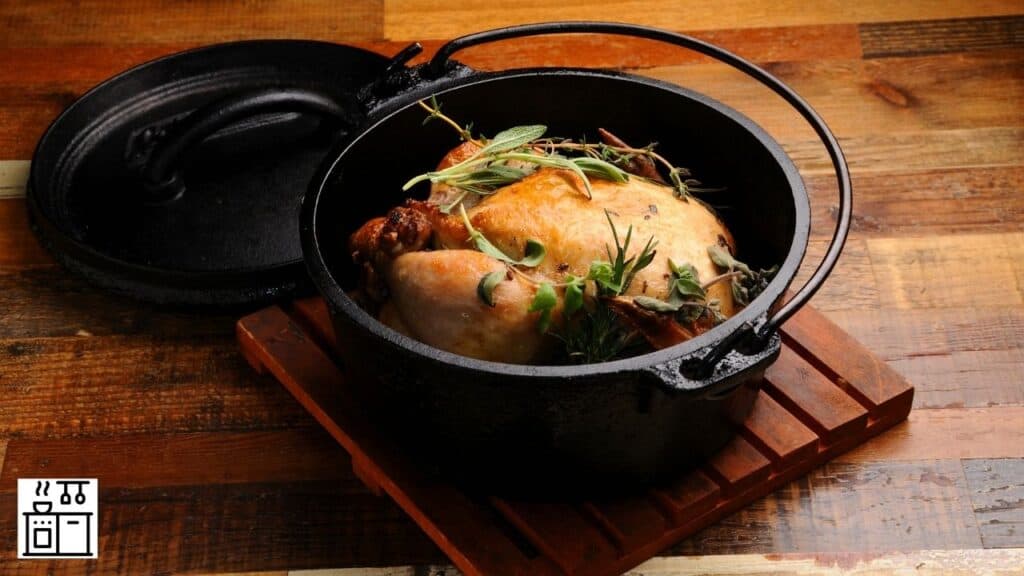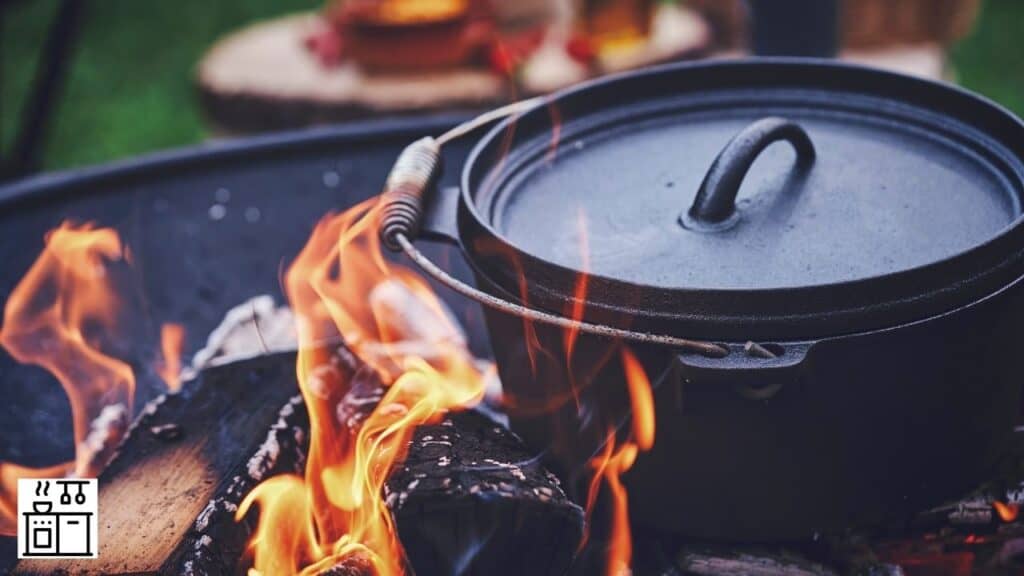All cooks love multi-purpose cookware, and Dutch ovens are the perfect example of such cookware. You can use these heavy-duty all-in-one pots for anything, from pasta and stews to casseroles and even bread. So how do Dutch ovens work?
Dutch ovens are deep pots with tight lids. They are suitable for stovetops and oven use. Dutch ovens are made of heavy heatproof metal or ceramic that conducts heat evenly. These materials help to retain the heat, and the tight lid helps to lock in the flavors. This makes the food tender and moist.
Let’s talk about the working of Dutch ovens in more detail now.
Inner Working Of Dutch Ovens
Dutch ovens are deep and heavy metallic or ceramic pots with tight-fitting lids.
They are large enough to hold a lot of ingredients. Heavy-duty metal or ceramic is used for construction.
These materials conduct heat evenly and allow the food to cook without burning.
Additionally, the heavy material used for construction retains heat and keeps food warm.
Dutch ovens have been used in cooking for centuries.
They were used all over the world, even before the emergence of gas and electric stovetops.
Interestingly, original Dutch ovens had feet to lift them above hot ashes and coals in a fireplace.
They were perfectly suited for traditional recipes like soups, casseroles, stews, roasts, and slow-cooked meals.
The main attraction of this type of cookware is that you can use it to prepare almost anything.
This extensive functionality is due to the size of the pot and the material that it’s made of.
Most Dutch ovens are cast iron, ceramic, or other heavy materials.
These materials are heatproof and hence suitable for high-temperature cooking.
So you can use them on stovetops as well as in ovens.
Dutch ovens have thick and flat bases that make them suitable for different cooking methods.
Recommended Further Reading:
- Are Dutch Ovens Suitable for Dishwashers?
- Utilizing a Dutch Oven in an Oven – Is it Possible?
- Can You Use a Cast Iron Skillets on a Glass Top Range?
How Does A Cast Iron Dutch Oven Work?
Traditional Dutch ovens were always made of cast iron because it’s a superior-quality cookware material.
It’s durable, versatile, and has excellent heating abilities.
Cast iron Dutch ovens also make cooking easy because of their natural seasoning that allows food to glide without sticking.
You can use cast iron Dutch ovens on the stovetop as well as in the oven.
It’s suitable for most cooking methods and recipes.
However, cast iron is heavier than most materials used in the kitchen.
It also requires extra care as it can easily rust.
However, a cast iron Dutch oven will serve you for years with good care and maintenance and can even be passed down to future generations.
If you use your cast iron Dutch oven properly, its functionality will improve with age.
Now, you must season most cast iron Dutch ovens before use.
Seasoning means applying a thin film of oil to the pot’s surface and heating it.
This process seals the natural gaps in the metal and makes it non-stick.
This layer of seasoning increases with continuous use, and the cast iron behaves just like a non-stick pan.
Once you have a good layer of seasoning, you can use your Dutch oven in endless ways.
The best thing about cast iron Dutch ovens is that they evenly distribute heat to cook ingredients thoroughly.
The lid allows you to lock the flavors in and keep the food moist and flavorful.
However, you should take special care when cleaning and storing a cast iron Dutch oven.
The natural patina or seasoning can get dislodged if you scrub it vigorously or use harsh cleaning agents.
Gentle washing with mild detergents is usually enough to clean Dutch ovens.
Additionally, you should wipe it thoroughly and store it away from moisture after washing.
Any exposure to moisture can make the surface rust and compromise the integrity of the metal.
Do Dutch Ovens Work On Induction?

With induction stovetops finding their way into all kitchens, it becomes necessary for cooks to choose cookware that works on these cooktops.
Fortunately, your Dutch oven will work on induction stoves.
Cast iron Dutch ovens are 100% induction compatible.
You can use Dutch ovens on induction stovetops to save up to 50% energy and time spent on conventional cooktops.
One of the main requirements for induction cookware is that the construction material should be magnetic.
Most Dutch ovens are made of cast iron, which is a magnetic material.
However, ceramic Dutch ovens will not work on induction ovens unless they have a magnetic metal base.
Induction cookware should also have a flat base for proper heat distribution.
Most of the modern Dutch ovens have flat bases and work well on induction cooktops.
However, some Dutch ovens may have rounded bases. They will not work on induction stoves.
Now, an important factor to remember is that induction stoves have fragile glass surfaces.
They are prone to scratches and cracks.
Since Dutch ovens are very heavy, you should be very careful when placing them and removing them from an induction cooktop.
Sudden movements or accidentally dropping them on the surface can shatter the cooktop, resulting in permanent damage.
Related Further Reading:
- Can Skillets Be Washed in the Dishwasher?
- Making Pans Compatible with Induction Hobs
- Can You Use A Griddle On A Glass Top Stove? [How To Do It?]
What Can You Use Dutch Ovens For?
Your cooking options are almost endless with a Dutch oven.
You can use it to prepare almost any type of dish.
Due to its construction and design features, Dutch ovens can directly go from the stovetop to the oven.
So you can even use it for recipes like casseroles and pasta dishes that involve both cooking and baking.
Classic Dutch ovens can even go from the oven or stovetop to the table because of their elegant design details.
Let’s now look at the different cooking methods for which Dutch ovens are suitable.
1. Simmering And Slow Cooking
The thick construction and deep and large size of a Dutch oven make it the perfect cookware for stews, soups, and other dishes that involve slow cooking.
Dutch ovens hold a constant temperature for a long time, thus cooking ingredients slowly and thoroughly.
So they are the perfect choice for flavorful and delicious stews, soups, and anything you can prepare in a slow cooker.
2. Boiling
You can use your Dutch oven to boil water or liquids for pasta, stews, soups, and other dishes.
They are deep, wide, and large enough to hold massive amounts of liquids.
You can also use them for various one-pot liquid-based recipes like curries.
3. Frying
The heavy metal or ceramic used in a Dutch oven allows precise temperature control.
Its surface can withstand high heat without being affected.
So Dutch ovens are good for deep frying and shallow frying food.
The only exception is if the inside of the Dutch oven has a non-stick coating.
In this case, you shouldn’t exceed the manufacturer’s recommendation and avoid overheating the pot.
4. Roasting
Dutch ovens heat well and retain heat. They withstand high temperatures.
Once heated, they hold the residual heat for hours. So they are great for roasting.
Dutch ovens also come with tight lids that seal moisture inside.
This helps the equipment roast ingredients and lock the flavors in. It also keeps the food moist and tender.
Interesting Further Reading:
- Can Refrigerators Store Pans?
- Are Dutch Ovens Worth It? [Limitations Of Dutch Ovens]
- Can Different Types of Pans Be Washed in the Dishwasher?
5. Baking
If you have a good quality Dutch oven, you can skip buying a dedicated bread maker or loaf tin.
You can use it for baking bread, cakes, and pizzas in a Dutch oven.
The thick base allows even heat transmission and bakes the ingredients thoroughly.
Bread and cakes made in Dutch ovens will have a perfect crust and light, airy insides.
6. Casserole Cooking
Dutch ovens are a good choice for preparing large batches of food.
You will find them very useful when entertaining or cooking large amounts of food.
You can start recipes like pasta bakes on the stovetop and transfer them directly into the oven for baking.
The heavy lids eliminate the need for aluminum foil, which you will usually need for browning casserole tops.

